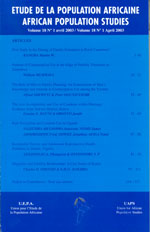
|
African Population Studies
Union for African Population Studies
ISSN: 0850-5780
Vol. 11, No. 1, 1996, pp. 63-74
|
 Bioline Code: ep96003
Bioline Code: ep96003
Full paper language: French
Document type: Research Article
Document available free of charge
|
|
|
African Population Studies, Vol. 11, No. 1, 1996, pp. 63-74
| en |
Hamadoun, Mahalmoudou
Abstract
The sedentary and nomadic communities of Goundam, which is located in the North of Mali, have been going through a crisis for a quarter of a century now. The multifarious droughts which are raging in the area have resulted in the degradation of existing natural resources, the slackening of development efforts, and have driven some into leaving the area. Then new survival strategies emerged, namely the redistribution of the population into the space and the concentration of production systems into the area's southern part, around the lakes, ponds and rivers. Obviously, this high mobility of people is not an unusual phenomenon in the area, for it is the very lifestyle of nomadic groups, but the phenomenon is so important now among sedentary people that it is difficult to identify the "real nomads" in that area. The mobility affects all other economic actors without any differentiation. Moreover, this mobility has also led to a housing and village dynamics (breaking-up of villages and conquest of new spaces), which is not without any consequence on the area's overall evolution.
|
| |
| fr |
La Mobilite Spatiale dans le Cercle de Goundam (Mali):Une Strategie de Survie
Hamadoun, Mahalmoudou
Résumé
Depuis bientôt 1/4 de siècle, les communautés sédentaires et nomades du cercle de Goundam dans le Nord malien sont en crise. Les sécheresses multiples et multiformes qui sévissent dans la zone ont entraîné la détérioration des ressources naturelles existantes, l'aménuisement des efforts de développement, et ont contraint certains au départ. Apparaissent ainsi de nouvelles stratégies de survie, notamment la redistribution des hommes sur l'espace et la concentration des systèmes de production dans la partie Sud du cercle autour des lacs, mares et fleuves. Certes, cette grande mobilité des hommes n'est pas un phénomène étrange dans la zone, car elle constitue un mode de vie pour les groupes nomades, mais le phénomène est si important aujourd'hui chez les sédentaires, qu'il est souvent difficile d'identifier les "vrais nomades" dans cette zone. La mobilité touche tous les acteurs économiques sans aucune différenciation. Par ailleurs, cette mobilité a entraîné aussi une dynamique de l'habitat et des villages (éclatement de villages et conquêtes de nouveaux espaces), ce qui n'est pas sans conséquence sur l'évolution d'ensemble de la zone.
|
| |
© Copyright 1996 - Union for African Population Studies
Alternative site location: http://www.uaps-uepa.org
|
|
